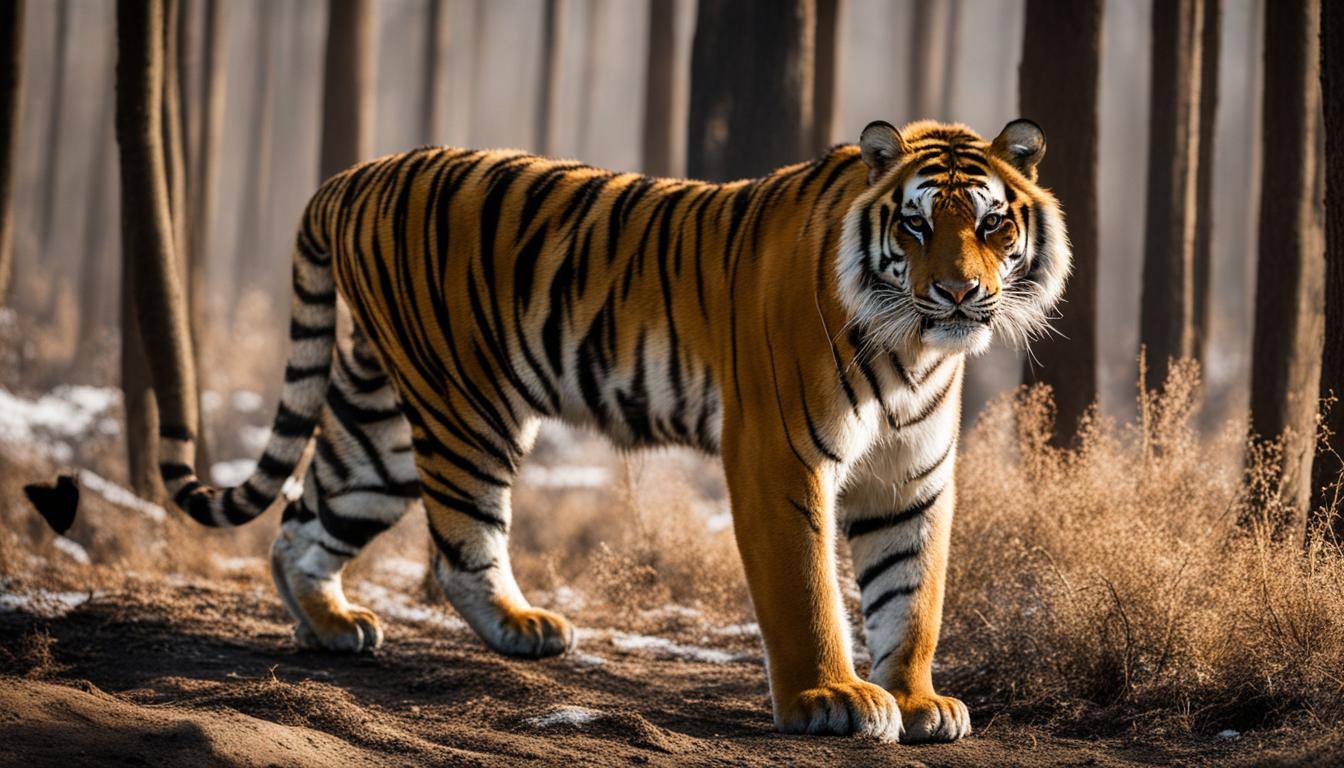The world’s tiger population has seen a sharp decline in the past century, with only about 3,900 individuals left in the wild. While poaching, deforestation, and development have been major factors, tigers are now facing a new threat from climate change.
Rising sea levels are shrinking coastal habitats for Bengal tigers, leading to conflicts with communities. Deforestation is accelerating climate change and pushing the critically endangered Sumatran tiger closer to extinction. Shifting temperatures are altering habitat for Siberian tigers, potentially leading to their extinction within the next 100 years. Natural disasters like wildfires and flooding, intensified by climate change, are destroying tiger habitats and increasing human-tiger conflicts.
Protecting tigers and their habitats is crucial for both tiger conservation and mitigating the impacts of climate change.
Key Takeaways:
- Climate change is shrinking coastal habitats, leading to conflicts between Bengal tigers and communities.
- Deforestation is accelerating climate change and endangering the critically endangered Sumatran tiger.
- Shifting temperatures are altering Siberian tiger habitats, increasing the risk of extinction.
- Natural disasters intensified by climate change, such as wildfires and flooding, are destroying tiger habitats.
- Protecting tigers and their habitats is essential for both conservation and addressing climate change.
Rising Sea Levels and Shrinking Habitats
Climate change is having a profound impact on tiger habitats, particularly in coastal regions. One of the major consequences of climate change is rising sea levels, which pose a significant threat to the survival of tigers in these areas.
Studies have shown that in the Sundarbans, the largest mangrove forest in India and Bangladesh, rising sea levels are causing the shrinking of coastal habitats for Bengal tigers. This is primarily due to erosion caused by higher waters and the intrusion of saltwater into freshwater sources. As a result, the tigers are being forced to search for new freshwater sources and move to higher ground, leading to conflicts with nearby communities.
The loss of coastal habitat is of great concern for the survival of Bengal tigers, as many of them have adapted to living in the unique mangrove ecosystem of the Sundarbans. If suitable habitat continues to diminish, the already endangered population of Bengal tigers may face a significant decline in the future.
The Impact of Rising Sea Levels on Bengal Tigers in the Sundarbans
| Threat | Impact |
|---|---|
| Shrinking habitat | Loss of suitable areas for Bengal tigers due to coastal erosion and saltwater intrusion |
| Conflicts with communities | Tigers forced to move to higher ground, leading to conflicts with human settlements |
“The loss of coastal habitat due to climate change poses a significant threat to the survival of Bengal tigers in the Sundarbans.” – Wildlife Conservation Society
The preservation of coastal habitats and the implementation of strategies to mitigate the effects of rising sea levels are crucial for the continued survival of Bengal tigers. Efforts must be made to protect these unique ecosystems and find sustainable solutions that benefit both tigers and local communities.
Deforestation and Its Impact on Tigers
Deforestation is a major threat to tigers in the face of climate change. As forests are cleared for various reasons, such as palm oil plantations, tiger habitats are destroyed, leaving these majestic creatures vulnerable and pushing them closer to extinction. The impact of deforestation on tiger populations is severe, as it disrupts their natural habitats and reduces their prey availability.
According to studies, the critically endangered Sumatran tiger is particularly affected by deforestation. With the destruction of their habitats, these tigers become more susceptible to illegal wildlife trafficking. It is crucial to address deforestation and halt the expansion of unsustainable industries that contribute to habitat loss.
Protecting tiger habitats is not only important for the survival of the species but also plays a significant role in combating climate change. Preserving forests helps reduce greenhouse gas emissions, mitigate the impacts of climate change, and maintain the delicate balance of ecosystems.
Implications of Deforestation
Deforestation significantly impacts tiger populations in several ways:
- Habitat loss: Tigers rely on forests for their survival. Deforestation robs them of their natural homes, leaving them with limited space and resources.
- Reduced prey availability: Deforestation disrupts the delicate balance of ecosystems, leading to a decline in tiger prey. Tigers depend on a healthy and abundant prey population to survive.
- Increased human-tiger conflicts: As tigers lose their habitats, they are forced to venture into human settlements in search of food. This heightens the risk of conflicts, endangering both tigers and human communities.
Addressing deforestation in tiger habitats is crucial for their survival and conserving biodiversity. It requires collective efforts from governments, conservation organizations, and sustainable industries to protect these magnificent creatures and ensure a sustainable future for both tigers and our planet.
| Impacts of Deforestation on Tigers | Consequences |
|---|---|
| Habitat loss | Reduces available space for tigers, putting their survival at risk. |
| Reduced prey availability | Disrupts the food chain, leading to a decline in tiger prey and threatening their survival. |
| Increased human-tiger conflicts | Forces tigers to seek food in human settlements, resulting in conflicts that endanger both tigers and communities. |
Temperature changes and habitat shift
Climate change is causing significant shifts in temperatures, which in turn are altering the habitat of Siberian tigers in Russia and China. The changing climate is leading to the transformation of Korean pine forests, as the trees are being replaced by fir and spruce trees. This shift is resulting in a decline in prey availability for hungry tigers, posing a severe threat to their survival.
The impact of these habitat changes is particularly concerning considering the already dwindling population of Siberian tigers, with fewer than 600 remaining in the wild. If these temperature shifts continue, it is projected that the Siberian tiger could face extinction within the next century. This would not only be a devastating loss for the world’s largest cat species but also for the ecosystems in which they play a vital role.
To mitigate the effects of climate change on tigers and prevent their extinction, it is essential to address the root causes of these temperature shifts. This includes reducing greenhouse gas emissions and implementing measures to stabilize global temperatures. Additionally, conservation efforts should focus on preserving and restoring the natural habitats of Siberian tigers, ensuring they have access to suitable prey and resources.
The table below showcases some key information regarding the impact of temperature changes on Siberian tigers:
| Key Points | Impact |
|---|---|
| Shifting temperatures | Altering the habitat of Siberian tigers |
| Transformation of Korean pine forests | Decline in prey availability |
| Dwindling tiger population | Potential extinction within a century |
| Importance of addressing climate change | Mitigating the effects on tigers and their habitats |
By taking immediate and concerted action to combat climate change and protect the habitats of Siberian tigers, we can strive to secure a future for these majestic creatures and ensure their continued role in maintaining the biodiversity and balance of our ecosystems.
The Impact of Natural Disasters on Tiger Habitats
Climate change is causing an increase in the frequency and intensity of natural disasters, which are having a devastating impact on the habitats of tigers. One of the most significant threats comes from wildfires, which are becoming more frequent in ecosystems that are not accustomed to such events. In regions like Siberia, temperate forests are experiencing intense wildfires that destroy the habitat and food sources of Siberian tigers. These fires not only displace the tigers but also disrupt their hunting patterns, leading to food scarcity and increased conflicts with humans.
Additionally, climate change is driving more intense storms and flooding, further exacerbating the challenges faced by tigers. Floods destroy crops and force local communities to encroach upon tiger habitats in search of livelihoods. This encroachment increases the likelihood of human-tiger conflicts, endangering both tigers and the local population. The loss of suitable habitat and the scarcity of prey due to flooding pose significant threats to the survival of tigers in these regions.
To address these challenges, it is imperative to implement measures that reduce the impact of natural disasters on tiger habitats. This includes promoting sustainable land management practices that prevent wildfires and protect forests from destruction. Furthermore, developing early warning systems and effective evacuation plans can help minimize the loss of human and tiger lives during storms and floods. By taking proactive measures and prioritizing the conservation of tiger habitats, we can mitigate the effects of climate change on these magnificent creatures and ensure their long-term survival.
Table: Impact of Natural Disasters on Tiger Habitats
| Natural Disaster | Effect on Tiger Habitats |
|---|---|
| Wildfires | Destroy habitat and food sources, lead to food scarcity and increased conflicts with humans |
| Flooding | Destroy crops, force encroachment on tiger habitats, increase human-tiger conflicts |
Protecting Tigers and Combating Climate Change
If we want to ensure the survival of tigers and mitigate the impacts of climate change, it is crucial to prioritize the protection of tiger habitats. Preserving forests, which serve as vital habitats for tigers, not only helps these magnificent creatures but also plays a significant role in reducing greenhouse gas emissions. By addressing deforestation and preserving tiger habitats, we can take a step towards combating climate change.
Conservation efforts are underway in countries like Indonesia and Brazil, where palm oil plantations contribute to deforestation and pose a threat to tiger habitats. Organizations are working to keep deforestation out of palm oil supply chains, thus protecting the natural habitats where tigers thrive. By supporting these conservation initiatives, we can help preserve critical tiger habitats and contribute to climate change mitigation.
Furthermore, protecting tigers and their habitats is not only vital for the survival of the species but also for maintaining the health of ecosystems and biodiversity as a whole. Tigers play a crucial role in maintaining the delicate balance of their ecosystems, and their presence is an indicator of a healthy and thriving environment. By working towards tiger conservation, we are also safeguarding the well-being of countless other plant and animal species that depend on these habitats.
| Actions to Protect Tigers and Combat Climate Change | Benefits |
|---|---|
| Preserving forests and tiger habitats | – Reduces greenhouse gas emissions – Protects endangered tiger species – Maintains ecosystem health and biodiversity |
| Addressing deforestation in palm oil supply chains | – Preserves critical tiger habitats – Mitigates climate change impact – Fosters sustainable practices |
| Supporting conservation initiatives | – Contributes to tiger population recovery – Protects ecosystems and biodiversity – Promotes sustainable development |
Preserving tiger habitats is a crucial step in combating climate change and ensuring the survival of these magnificent creatures. By taking action now, we can make a positive impact on both the tiger population and the health of our planet. Together, we can protect tigers and preserve their habitats for generations to come.
The Impact of Climate Change on Bengal Tigers in the Sundarbans
The Sundarbans, located in southern coastal Bangladesh, is home to the largest surviving mangrove habitat and the last population of Bengal tigers adapted to living in a mangrove ecosystem. However, this unique and fragile ecosystem is under significant threat from climate change and sea-level rise, posing a severe risk to the survival of Bengal tigers.
Projections indicate that by 2070, there may be no suitable habitat remaining for Bengal tigers in the Sundarbans. This is alarming considering that Bengal tigers account for about half of the world’s wild tiger population. The effects of climate change, such as rising sea levels and increased erosion, are shrinking and degrading the tigers’ habitat, leading to a decrease in their available prey and resources.
The implications of these changes are far-reaching. With the loss of suitable habitat, Bengal tigers are forced to search for alternative freshwater sources and move to higher ground, which in turn increases conflicts between tigers and nearby communities. This puts both humans and tigers at risk, further exacerbating the challenges faced by these beautiful creatures.
| Threats to Bengal Tigers from Climate Change | Impacts |
|---|---|
| Rising sea levels and coastal erosion | Loss and degradation of mangrove habitat, conflicts with communities |
| Decreased prey availability | Reduced food sources for tigers, higher competition for limited resources |
| Increased human-tiger conflicts | Risk to both humans and tigers due to habitat loss and resource scarcity |
Protecting the Bengal tigers of the Sundarbans is of utmost importance. Conservation efforts must focus on mitigating the impacts of climate change, preserving and restoring mangrove habitats, and promoting sustainable practices that reduce human-tiger conflicts. Only through these concerted efforts can we ensure the survival of these majestic creatures and maintain the delicate balance of our ecosystems.
Conclusion
Tigers, one of the most majestic creatures on Earth, are facing numerous threats, including the detrimental effects of climate change on their habitats. The world’s tiger population has declined significantly, with only about 3,900 individuals left in the wild. While factors like poaching and deforestation have played a major role, climate change is now emerging as a new and formidable threat.
Climate change impacts tigers in various ways. Rising sea levels are shrinking coastal habitats for Bengal tigers, leading to conflicts with communities. Deforestation, driven by activities like unsustainable palm oil production, is not only accelerating climate change but also pushing the critically endangered Sumatran tiger closer to extinction. Shifting temperatures are altering the habitat of Siberian tigers, putting them at risk of extinction within the next century. Furthermore, intensified natural disasters like wildfires and flooding, exacerbated by climate change, are wreaking havoc on tiger habitats and increasing human-tiger conflicts.
Protecting tigers and their habitats is crucial for both tiger conservation and mitigating the impacts of climate change. Preserving forests, which serve as important tiger habitats, helps combat climate change by reducing greenhouse gas emissions. Conservation efforts in palm oil-producing countries aim to keep deforestation out of supply chains and protect crucial tiger habitats. By addressing climate change and preserving tiger habitats, we can give tigers and the planet a fighting chance.
FAQ
How are tigers affected by climate change in their habitats?
Climate change is impacting tiger habitats in various ways, including rising sea levels, deforestation, temperature changes, and natural disasters. These factors are leading to habitat loss, food scarcity, and increased human-tiger conflicts.
How does rising sea levels affect tiger habitats?
Rising sea levels shrink coastal habitats for tigers, such as the Sundarbans in India and Bangladesh, resulting in conflicts with communities. Tigers have to find new freshwater sources and move to higher ground, endangering their survival.
What is the impact of deforestation on tigers?
Deforestation accelerates climate change and pushes tigers, like the critically endangered Sumatran tiger, closer to extinction. Destroying tiger habitats increases their vulnerability to illegal wildlife trafficking and disrupts their natural prey availability.
How do temperature changes affect tiger habitats?
Shifting temperatures caused by climate change alter the habitat of tigers, such as the Siberian tiger. Prey availability declines as climate change causes changes in forests and vegetation, posing a significant threat to the survival of these majestic cats.
How do natural disasters intensify human-tiger conflicts?
Climate change contributes to more frequent and intense wildfires and flooding, destroying tiger habitats and forcing tigers and humans to compete for resources. These natural disasters increase the risk of conflicts between tigers and local communities.
How can we protect tigers and combat climate change?
Protecting tiger habitats is crucial for both tiger conservation and mitigating climate change. Preserving forests reduces greenhouse gas emissions and helps safeguard tigers. Conservation efforts and sustainable practices are essential to achieve these goals.
What is the impact of climate change on Bengal tigers in the Sundarbans?
Climate change and sea-level rise pose a significant threat to suitable tiger habitats in the Sundarbans, leading to potential extinctions. As Bengal tigers account for about half of the world’s wild tiger population, this poses a severe risk to their survival.
Why is tiger conservation important for mitigating climate change?
Protecting tigers and their habitats is crucial for tiger survival and maintaining healthy ecosystems. Preserving forests reduces greenhouse gas emissions and contributes to climate change mitigation, making tiger conservation an essential component of climate action.







